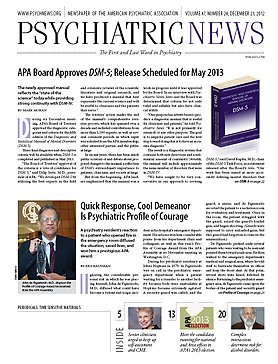A study has characterized the natural course of depressive symptoms for up to a 20-year period in older women, and it appears to be the first such study to do so.
The study, which was headed by Amy Byers, Ph.D., an assistant professor of psychiatry at the University of California, San Francisco, was published in the October Archives of General Psychiatry.
The cohort included more than 7,000 community-dwelling women aged 65 or older who were recruited in Baltimore, Pittsburgh, Minneapolis, and Portland, Ore. The short form of the Geriatric Depression Scale was used to assess subjects’ depressive symptoms at two, six, 10, 16, and 20 years after study onset.
Among the questions asked were “Are you basically satisfied with your life?” “Have you dropped many of your activities and interests?” “Do you often get bored?” and “Do you feel full of energy?” Subjects had to answer each question yes or no. The responses were scored; a score of 0-5 was normal; a score greater than 5 suggested depression. The average number of depression assessments conducted per subject was three, and the average follow-up time per subject was 12 years.
The researchers found that the women fell into one of four groups—28 percent experienced minimal depressive symptoms, 54 percent experienced persistently low depressive symptoms, 15 percent experienced increasing depressive symptoms, and 3 percent experienced persistently high depressive symptoms.
The odds for belonging to the increasing-depressive-symptom class or the persistently high depressive-symptom class, compared with the group having minimal depressive symptoms, were substantially and significantly raised. when baseline factors of smoking, physical inactivity, a small social network, physical impairment, heart-attack history, diabetes, or obesity were present.
The strongest association was seen with physical impairment, for which the chances of increasing depressive symptoms or persistently high depressive symptoms during the course of 20 years were eight times higher, and 16 times higher, respectively, compared with subjects having no physical impairment.
The results thus suggest that strategies are needed to reduce depressive symptoms in the almost 20 percent of older women who experience increasing depressive symptoms or persistently high depressive symptoms. “In particular, our study results suggest that modifiable risk factors such as a reduction in obesity, increased physical activity or exercise, and more social engagement or connectedness may help to reduce the progression of symptom burden,” the researchers said in their report.
The use of maintenance regimens of antidepressants might help such women as well, they suggested. “Current antidepressant use was low in our study, and ever use was less than 50 percent for those in the highest trajectory group.”
“I think what is particularly impressive about our work is that it highlights the importance of lifestyle factors such as physical inactivity and lack of social networks in predicting high and increasing trajectories of depressive symptoms into late life,” Byers told Psychiatric News. “Thus this work supports the importance of a healthy and positive lifestyle, staying physically as well as socially active across the lifespan. Our work is particularly novel as few studies have considered the importance of lifestyle factors as predictors of depression above and beyond morbidity. In addition, our study shows how robust lifestyle factors are in impacting high and increasing depressive symptoms over a very long trajectory of time.”
The study was funded by the National Institutes of Health and the U.S. Public Health Service. ■
